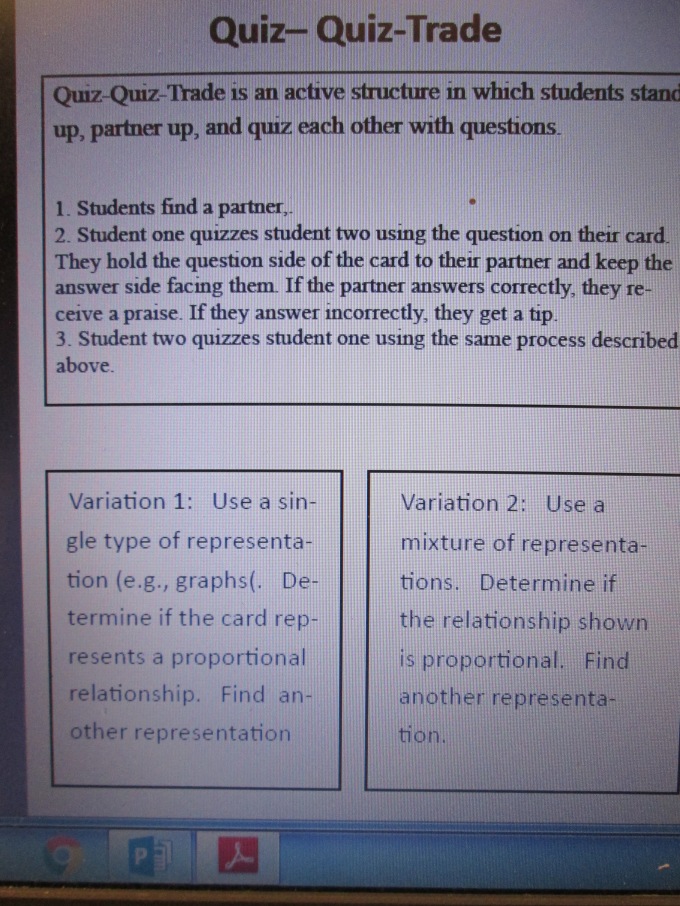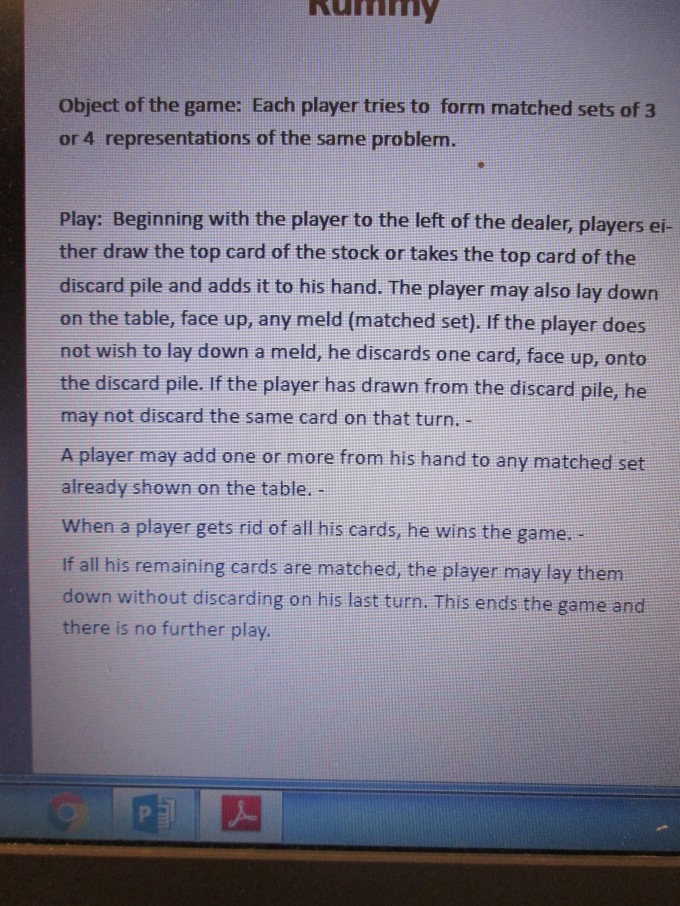Successful design is not the achievement of perfection but the minimization and accommodation of imperfection. – Henry Petroski
I know that I will not ever design the perfect lesson any more than I will ever create the perfect design as an engineer. I’m not sure that perfect exists in this world. While Dr Petroski (a civil engineering and history professor at Duke University) focused his work on failure analysis in an engineering context, the underlying principle he espouses applies to my work as an educator as well. On any given day, I know that some students will walk away not having fully mastered the concepts addressed in class. So, I plan ways to revisit concepts in small chunks of time until everyone does “get it.” When I plan ways to revisit concepts, I try to create activities that I can use a lot of different ways because I want to be able to use them more than once rather than having to create an endless array of materials.
Proportional Relationships – What I Want Them To Know
I want students to know that proportional relationships are linear and go through the origin.
Proportional Relationships – What I Want Them To Be Able To Do
I want to ensure that students see proportional relationships in tables, graphs, equations, and word problems. In each representation, I want them to see the constant rate of change and that there is no “start-up” value (the y-intercept is 0). I want to incorporate Trail’s work (Twice-Exceptional Gifted Children) to support conceptual learners, so I envision a whole-part-whole instructional sequence: what is a proportional relationship; how do you see it in a table, how do you see it in a graph, how do you see it in an equation, how do you see it in a word problem; how is the constant rate of change shown in each representation, how is the “no-start up” shown in each representation (compare and contrast these in the different representations).
Proportional Relationship Cards
I created a set of 48 cards. There are twelve cards for each of the four representations. The cards can be used separately or together. That is, I can use just the cards relating to a single representation if I want to focus on that representation. Alternatively, I can use cards from all four representations if I want students to make connections across representations. You can download the cards and game instructions by clicking on the link below the photos.
Proportional Relationship Card Sort and Game
Activity 1 – Quiz-Quiz-Trade
Quiz-Quiz-Trade is a Kagan Cooperative Learning Structure. In this structure, students partner and quiz each other. Then, they find a new partner and repeat the process. Marzano’s research (Classroom Instruction That Works) shows that using cooperative learning structures produces gains of 27% It also shows that incorporating movement increases levels of engagement (The Highly Engaged Classroom).

Activity Two – Give One, Get One
Like Quiz-Quiz-Trade, students work with a partner and quiz each other. I will use this activity when I want students to make connections across representations. It incorporates movement and a cooperative learning structure. It is outlined in Marzano’s The Highly Engaged Classroom. I have students form two lines facing each other with about three feet in between the lines (the structure does not specify this, but I find it works well this way). Each student is given a card. I will give one line a single representation and the other line a different representation. The cards for partners will be different representations of the same problem. Each partner will have to find the rate of change and the y-intercept using their card. When a partner has found them, he or she steps forward. When both partners are in the middle, they quiz each other on what the rate of change is/how it is shown on their card and on the y-intercept/how it is shown in their card. When they are done, they step back into the line. When all the pairs are done, have one line pass their card to the next person and the other line shift (line one passes the card down one, line two shifts up one).
This is an activity that I do for 5 minutes at the end or start of class. I end it based on time. I don’t try to have every student do every problem.
Activity Three – Rummy
Students play in groups of 2 to 4 players. They use the entire set of 48 cards to match the table, graph, equation, and word problem.

This is an activity I will use so that students compare and contrast the different representations. Marzano’s research (Classroom Instruction That Works) shows that finding similarities and differences can produce gains of 45%. His research (The Highly Engaged Classroom) also shows that using a game increases levels of engagement.
I may have students play the game in heterogenous groups as a general review activity.
I may use this as a differentiated instruction activity. I will have students play the game in groups according to their level of mastery. Students who have not attained mastery play the game. Students who have attained mastery play a different game reflective of their own skill gaps.
I will have students play the game for 5-10 minutes at the end of class. If the game is not over, the player with the most sets wins the game (and a piece of candy)
Activity Four – Card Sort with Three Variations
Students work individually, in pairs, or in table groups to sort the cards. In the first variation, they work with a single representation and sort them into proportional/not proportional categories. In the second variation, they work with a mixture of representations to sort them into proportional/not proportional categories. In the third variation, they work with a mixed set of representations and find the matching cards (same situation represented in a table, graph, equation, word problem).
I may have students work in table groups as a general review activity.
I may have students work with intentional pairing. In this scenario, I pair a student who is struggling with the concept with a student who has mastered the concept. As they sort the cards, the discussion is scaffolded for the student who has not yet attained mastery.
I may have students work individually and use this as a formative assessment.





3 thoughts on “Accommodating Imperfection – Proportional Relationships Cards with Multiple Variations For Play”